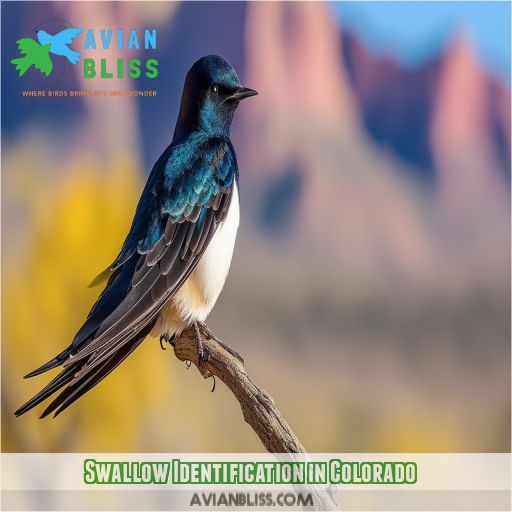This site is supported by our readers. We may earn a commission, at no cost to you, if you purchase through links.

Let’s talk about identification. How do you tell these birds apart? From their physical characteristics to their range and migration patterns, there’s a lot to learn.
But it’s not just about looks – their behaviors are just as fascinating. What do swallows eat, and how do they catch their prey? We’ll dive into their foraging habits and explore what makes them so successful.
And then there’s the important stuff – conservation. How can we protect these amazing birds and their habitats? What are the biggest threats they face, and what can we do to help?
Let’s explore the fascinating world of swallows in Colorado and learn more about their interesting lifestyles.
Table Of Contents
- Key Takeaways
- Swallow Identification in Colorado
- Range of Swallow Species in Colorado
- Swallow Foraging Behavior and Habitats in Colorado
- Swallow Migration Patterns and Nesting Habits in Colorado
- Conservation of Swallow Species in Colorado
- Human-Swallow Interactions and Legal Considerations
- Frequently Asked Questions (FAQs)
- Conclusion
Key Takeaways
- Colorado is home to eight unique species of swallows, each with distinct looks and habits.
- These insect-eating birds have a variety of foraging behaviors and habitat preferences, from the versatile bank swallow to the colony-loving cliff swallow.
- Conservation efforts are important to protect swallow populations facing threats like habitat loss, pesticide use, and climate change.
- Humans and swallows have a complex relationship, with swallows benefiting from human structures for nesting, but sometimes causing nuisance issues.
Swallow Identification in Colorado
Colorado is home to eight species of swallows, each with unique characteristics that make identification a fascinating challenge. Here’s a guide to help you distinguish these graceful birds:
Bank Swallow: Look for a grayish brown back, head, and wings, with a white underside and throat. A distinctive feature is the grayish brown chest band and stripe.
Barn Swallow: This species stands out with its navy blue back and head, complemented by grayish-blue tail and wings. The face is a vibrant reddish-orange, with a lighter orange underside and undertail. Keep an eye out for their forked tail.
Cave Swallow: The dark blue back and top of the head contrast with the gray wings. Notice the orange face and underside, along with the orange patch above the bill and on the rump. Their tail is squared off.
Cliff Swallow: Another blue-backed swallow, with a dark blue back and head, and dark gray wings and tail. The reddish-orange face and light orange rump are eye-catching. Look for the white marking above the bill and their squared-off tail.
Northern Rough-winged Swallow: This swallow has a uniform brown back, wings, head, and tail. Their underside is lighter, with a brownish-gray wash over the chest. Their tail is short and squared off.
Range of Swallow Species in Colorado
The range of swallow species in Colorado varies, with some species, like the bank swallow, having a broader range that extends into Canada and Alaska, while others, like the cave swallow, are more limited to the southern regions of the US and Mexico.
The barn swallow and cliff swallow are the most common species in Colorado. The barn swallow is widespread across the United States during summer, often perching on fences and wires, while the cliff swallow is found in large numbers over open areas, canyons, rivers, and lakes.
The violet-green swallow, with its vibrant turquoise plumage, prefers open areas with trees and water, making parks and meadows ideal habitats.
Each swallow species has its unique distribution and habitat preferences, but they all contribute to the vibrant bird life in Colorado during the summer months.
Swallow Foraging Behavior and Habitats in Colorado
Swallows in Colorado have unique foraging behaviors and habitat preferences. These birds are insectivores, and their diet primarily consists of flying insects. The specific insects they feed on vary by species. For example, cliff swallows target flying ants, bees, wasps, flies, and crickets, while bank swallows occasionally scoop insects from the water’s surface.
The foraging behavior of swallows also differs. Bank swallows are versatile, foraging solo or in groups. Cave swallows tend to flock loosely and sometimes associate with other swallow species. Cliff swallows soar and forage over open areas, canyons, rivers, and lakes, often in large numbers. Northern rough-winged swallows fly lower over the water and often forage in groups.
Regarding habitats, swallows can be found in a variety of settings. Bank swallows prefer areas near water, such as riverbanks and coastlines, and they nest in bluffs, cliffsides, or man-made structures. Barn swallows are widespread and can be spotted over meadows, open spaces, and areas near water. They commonly nest in barns, bridges, and other structures. Cave swallows, true to their name, are often found around caves, bridges, and large culverts. Cliff swallows also favor open areas, canyons, and bodies of water, and they nest in bridges, tall buildings, and cliffsides. Finally, Northern rough-winged swallows are typically found near water sources like lakes, rivers, and streams.
Swallow Migration Patterns and Nesting Habits in Colorado
As summer rolls around, Colorado welcomes back its migratory birds, including eight species of swallows. These graceful fliers migrate to South and/or Central America for the winter, where the climate is warmer and insects are plentiful. Come spring, they return to Colorado to breed and raise their young.
Cliff swallows and barn swallows, the most common species in the state, have adapted well to human settlements. They’ve traded their original nesting spots on cliffs and canyon walls for manmade structures like buildings and bridges. Cliff swallows, in particular, are known for their distinctive mud nests, often built under bridges or even the eaves of buildings. These nests are small, clay-like beehives where they safely raise their chicks.
Barn swallows, on the other hand, prefer to nest alone or in small groups, crafting cup-shaped nests in barns, sheds, and other open structures. You’ll often spot them perching on fences and wires, showcasing their sleek, blue backs and distinctive, long, forked tails.
Conservation of Swallow Species in Colorado
Swallow populations in Colorado have been declining due to habitat loss, pesticide use, and climate change. To protect these feathered friends, it’s important to focus on conservation efforts.
Protecting their nesting sites and providing suitable habitats is key for their survival. This might include preserving natural habitats, such as cliffs and canyons, and ensuring that artificial habitats like buildings and bridges remain accessible to them.
Additionally, reducing pesticide use and promoting sustainable farming practices can have a positive impact on swallow populations. Pesticides harm insects, their primary food source, but also pose risks to the birds.
The ecological value of swallows is significant. They play an essential role in controlling insect populations, including mosquitoes and flies. By conserving swallows, we protect a beautiful bird species and maintain a natural balance in our ecosystems.
Conservation efforts can also include supporting organizations dedicated to bird conservation and promoting education about the importance of swallows in our environment.
Human-Swallow Interactions and Legal Considerations
While swallows and humans coexist in Colorado, their proximity raises legal considerations. Protecting swallow nesting sites and reducing pesticide use are key to their survival.
Swallow Interactions with People
Swallows and humans have a complex relationship.
Swallows benefit from human structures for nesting, but their nesting habits can sometimes be a nuisance.
They may build nests under bridges or in buildings, which can create a mess or cause damage.
Additionally, swallows feeding on insects can provide a natural pest control service, benefiting humans.
However, their presence in large numbers can also raise safety concerns, especially near airports, where bird strikes are a potential hazard.
Legal Considerations
Swallows can be a joy to watch, but they can also be a bit of a headache.
There are rules and laws you need to be aware of, especially if you’re dealing with nesting swallows or bird mites.
You’ll need to check with your local area about permits for trapping or removing them.
Also, be aware of bird spikes and other deterrents, since they might be regulated by the Environmental Protection Agency.
Swallow Conservation
Swallow conservation is important due to population decline. Protect nesting sites and habitats, reduce pesticides, and support bird conservation organizations. These actions help keep swallows around for the long haul.
Frequently Asked Questions (FAQs)
When can you knock down swallows nest in Colorado?
You can knock down swallows’ nests in Colorado when they’re empty. This is usually in fall or winter, after the birds have migrated. If you’re sure there are no eggs or young birds, you can remove the nests sooner.
Are swallows protected in Colorado?
Yes, swallows are protected in Colorado. It’s illegal to destroy or take down an active nest, and they’re also protected by state regulations. This is due to the federal Migratory Bird Treaty Act of
What are the blue and white swallows in Colorado?
The blue and white swallows in Colorado are the Purple Martin, Tree Swallow, and Cliff Swallow. The Purple Martin has a light-colored belly, while the Tree Swallow has a white throat and underside. The Cliff Swallow has a dark body and a light cream-colored belly.
What are the nuisance birds in Colorado?
Pigeons, European starlings, house sparrows, cliff swallows, barn swallows, and northern flickers are considered nuisance birds in Colorado. Bird control systems can help manage these issues.
What do swallows eat?
Swallows eat mostly flying insects, including mosquitoes, caterpillars, grasshoppers, crickets, spiders, snails, and worms. They’re insectivores, with flying insects making up 99% of their diet.
Where do they nest?
Cliff swallows build mud nests under bridges, cliffs, and eaves of buildings. Barn swallows nest in barns, sheds, and other open structures.
When do swallows migrate?
Swallows migrate south to Central and South America during September and October, when food becomes scarce. They return to Europe and North America in the spring, usually between late March and early May.
How do they behave?
They’re the free-spirited adventurers of the bird world, swooping and diving with graceful elegance. Some, like the cliff swallow, prefer the company of their own kind, often found in large colonies. Others, like the barn swallow, are solo adventurers, occasionally joining small groups.
What do they look like?
The Cliff Swallow is the only square-tailed swallow in most of North America.
It has a white forehead, dark, rust-colored throat, and steel-blue crown and back.
The Cave Swallow is similar, but with a rust-colored forehead and pale throat.
The Barn Swallow has a long, deeply forked tail.
The Purple Martin is blue-colored, with a light-colored belly.
The Bank Swallow has a grayish-brown back, head, and wings, with a white underside and throat.
Conclusion
We’ve taken a closer look at the fascinating world of swallows in Colorado, uncovering the unique characteristics of each of the eight species that call this state home.
From identification tips to migration patterns, foraging habits, and conservation efforts, we’ve dug into the details that make these birds so interesting.









